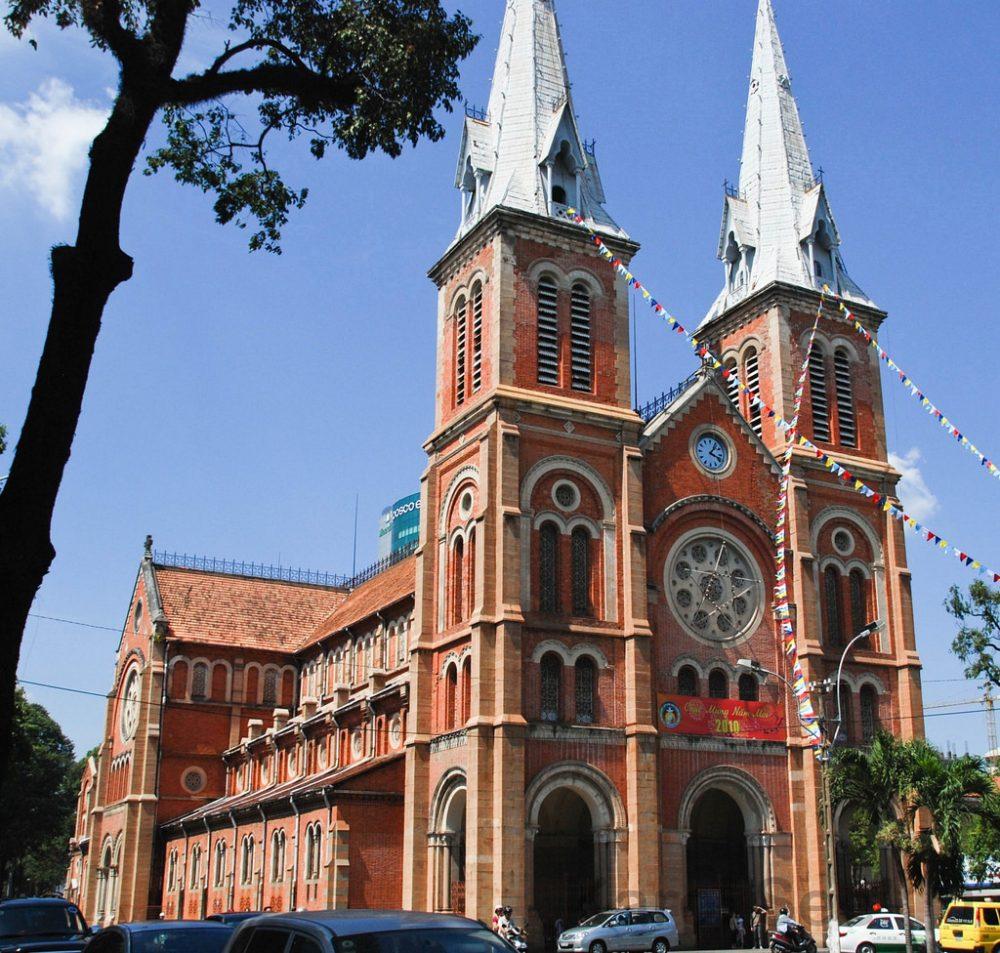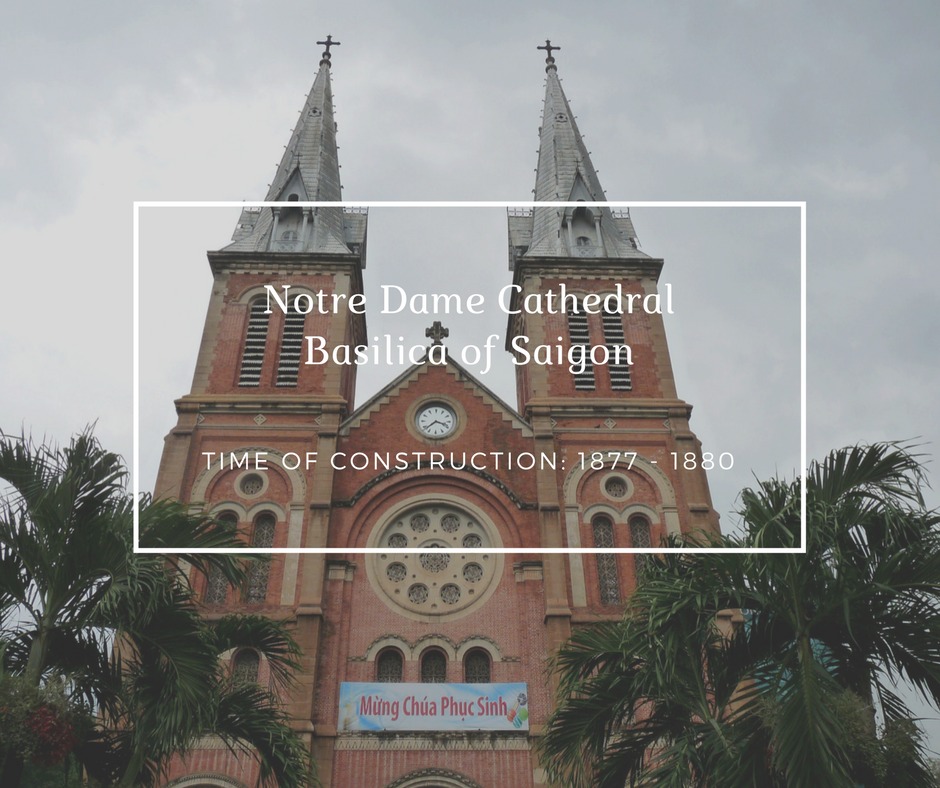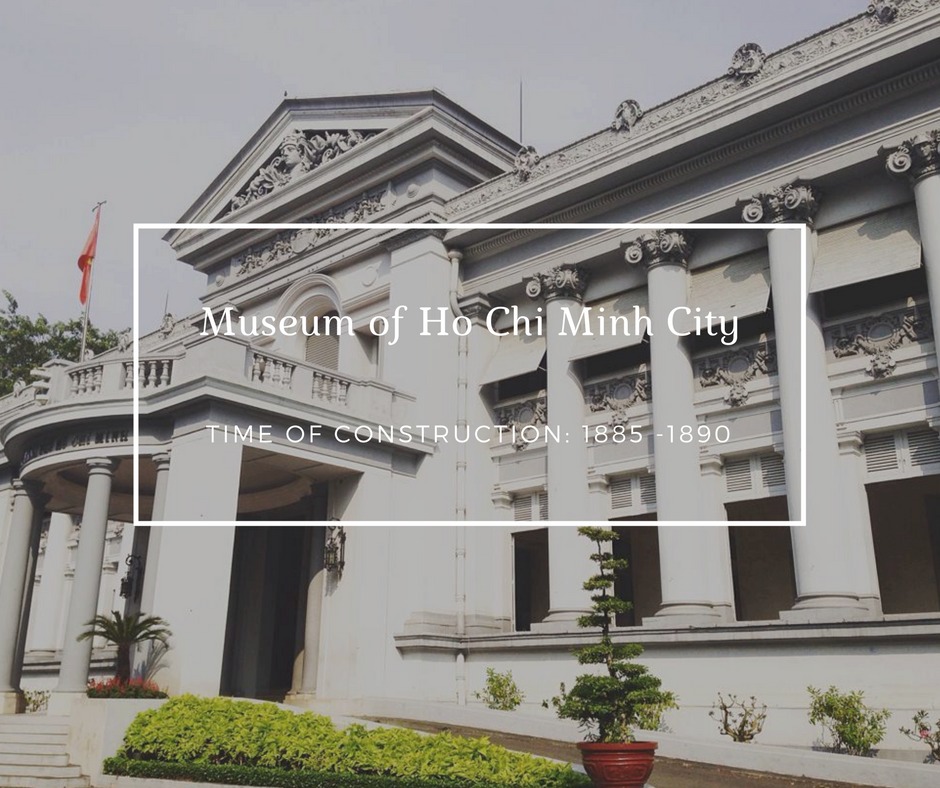Things you might not know about Saigon's most famous colonial buildings

Buildings in Ho Chi Minh City have a huge influence on foreign countries, especially French and China, two that have a long time ruled over Vietnam during the history. Learning about these buildings not only gives you knowledge in terms of art and architecture but also helps you understand further Vietnamese history and culture. If you notably admire the Notre Dame Cathedral, a typical French construction, then you must see other nine buildings on the list.
Notre Dame Cathedral Basilica of Saigon
Having existed for more than 140 years, Notre Dame Cathedral Basilica of Saigon (or Nha tho Duc Ba Sai Gon to the locals) is a glamorous religious building, an architectural masterpiece of Ho Chi Minh city. Churches and cathedrals, along with Catholicism entered Vietnam around the 16th century and became popular in the 19th century due to French colonialism. The first ever cathedral was built right after the French colonists took over Saigon in order to implement Catholic rituals, on the base of an old abandoned house on Ngo Duc Ke street. With the strong development of Catholicism in Saigon, people demanded a larger cathedral. Architect J.Bourard was appointed to design, organize and supervise the construction. In 1877, Archbishop Isidore Colombert put the first brick on the foundation of the cathedral, at an event with the attendance of important politicians of the time. After 3 years of continuous construction, the cathedral was finally opened on Easter Sunday.

The original design of Notre Dame Cathedral didn't comprise of the bell towers that we see today, they were added in 1895. The two bell towers have a symmetrical structure, stand right at the front of the cathedral and helped contribute further to the perfection of the whole building. Each contains 3 large bells and the height of the towers is about 57.6m from the ground to the top The last born composition was the Virgin statue, which was built in 1959. Since then, the local people started calling the cathedral “Duc Ba Cathedral", which refers to the Virgin statue. In 1962, it was promoted to ‘Basilica’, a special name only used for certain churches or cathedrals which attain historic and religious importance. Throughout lots of historical and political war time events in Vietnam, the cathedral wasn't damaged as much as many other buildings and it still retains its majesty and splendor. The cathedral has a very special position, right next to the busy intersection without any fences or protection, surrounded by a handful of other city highlights and with a great view. All of the materials used for the building, decoration, and interior of the Notre Dame Cathedral were directly imported from France. The foundations were specially designed to handle a mass which is 10 times heavier than the current building. The whole cathedral was perfectly constructed with precise calculations in each ratio and structure. That somehow explains why the quality of the building hasn't changed much in the past century. The main hall is 135m in length and 35m wide, symmetrically structured, ascends high inwards and is followed by a Romanian and Gothic architectural style. It can provide a large capacity of 1200 people at the same time. The bell tower in front of the cathedral is one of tallest ones in Vietnam so far, the bells were also made in France and have the finest sound. The only thing which was not French made is the clock, which was produced by the Swedish in 1887 and is still operating perfectly.
Saigon Central Post Office
Saigon Central Post Office is another excellent design by the French in Ho Chi Minh city, located at number 2, Cong Xa Paris street, District 1. The building was built following a Gothic design from 1886 - 1891, according to the blueprint of the architect Villedieu and his assistant Foulhoux. The purpose of the building is to serve communications for residents and army personnel with the main services being postal transfers and telecommunications.After the opening of Saigon Central Post Office, the post office system connected Saigon - Quy Nhon - Hue - Vinh - Hanoi with a total length of more than 2000m once finished in 1888. In 1889, a post office line between Saigon and Bangkok was established to serve the demand of businesses. In 1894, Saigon had the first telecommunications system. Nowadays, 14 pay phone booths are still retained to serve daily residents and visitors communication demands.

Saigon Central Post Office’s architecture is a great example of how the Western and Eastern culture was greatly blended. The first ỉmpession right when you walk into the building is the huge domes on the ceiling, right at the front gate. On the wall are 2 big historic maps. On the right side, you'll see the map of Saigon and its surrounding provinces in 1882. The left is the map of Vietnam and Cambodia electronic cable network in 1936. The external decoration is divided into plenty of rectangles, with the name of communications and electronic inventors sculpted inside each. Each rectangle has a sculpture of a person wearing a laurel. There's also a clock hanging right above the front gate, with the years of construction and opening recorded.
Norodom Palace (Reunification Palace)
Built during the early time of French colonialism in Vietnam, Reunification Palace used to be one of the most beautiful owned-by-government villas, where most powerful figures stayed and influential historic events happened. After 6 Southern provinces all belonged to the French in 1886, the French government decided to build a place to serve the Indochina governor. Reunification Palace, at first, was named Norodom Palace and was built within 3 years with the majority of construction materials imported from France. Owning an 80m wide facade, the Palace could offer space for more than 800 people. It was surrounded by a large garden, and a cannon was placed at the front for decoration.

From 1887 to 1945, this place served many generations of governors and their families, also the headquarter of French colonialism throughout the whole of Indochina. By 1954, the French had removed all of their forces from Vietnam, the Palace was then taken over by prime minister Ngo Thoi Nhiem and renamed the Reunification Palace. However, in 1962, the palace was damaged by a heavy attack of the Saigon air force. As the damage was significant, Ngo Dinh Nhiem decided to destroy the whole building and build another. The current Reunification Palace that we see today was built on the ground of the original one but designed by the Vietnamese architect Ngo Viet Thu. In 1975, the Reunification Palace was where the agreement to reunite the South and the North of Vietnam was signed to end nearly 30 years of the Vietnam - American war. The total space of the Reunification Palace is 4.500m2, in which the usable area is 2.200m2. The building has 3 floors, 1 rooftop, 1 ground, 2 basements and one ground for helicopter landings. The building also comprises of more than 100 rooms with different designs and which serve different purposes. The basements are a weapon-proof design. During its history, The Reunification Palace was bombed twice.
Ben Thanh Market
As noted in many history books, Ben Thanh market had been established long before the French colonist invasion. The market is located on the bank of Ben Nghe river, the main gateway for visitors and soldiers to enter Gia Dinh Citadel (which was District 1 and District 3 in the past). This area was named Ben Thanh, hence people called the market Ben Thanh accordingly. In 1911, the original Ben Thanh market was so old and run down. The French government decided to build a bigger one to serve the higher commercial demands and relocated the market to its current location.

Ben Thanh market stays at a prime location with 4 facades, accessible via 4 main streets of the city, which facilitated trading and transportation. Nowadays, besides being known as a tourist attraction, Ben Thanh market is also a commercial and cultural exchange hub. With a space of 13.056m2, 4 main gates (East, West, North, South) and 12 sub gates, there are nearly 1500 vendors selling various type of services and products inside the market, from textiles, clothing, footwear, handicrafts, food and fresh ingredients. In which, handicrafts are the most sold category here in terms of vendor quantity, many vendors are family run business continuing generations of trade. Ben Thanh market is estimated to have more than 10,000 visitors per day.
Museum of Ho Chi Minh City
As one of the most visited museums in Saigon and listed in the “100 interesting things about Ho Chi Minh city", the Museum of Ho Chi Minh city itself is a gorgeous architectural masterpiece that represents the influence of French culture on Ho Chi Minh city.Built from 1885 to 1890 by the French architect Alfred Foulhoux, the original museum was called the Museum of Commerce, to introduce trading and production activities in the South. However, its meaning is beyond that as the museum was where lots of influential events happened. In 1945, this is where the General Yoshio Minoda of the Japanese army gave up his sword as a statement of loss to their alliance. After 1975, the Saigon People Committee renamed it to the Museum of Southern Evolution. In 1999 it was officially named as the Museum of Ho Chi Minh city that we know today.

The building is a harmonious blend of different design cultures including Gothic, Romanian and some inspiration from the Mekong Delta lifestyle. The total area is 1200m2. At the front gate is the statue of the “Trading god" wearing a crown. You will also see lots of huge poles with sophisticated decorations. Each pole has a statue of a French guardian, which represents the protection towards the building. Lion heads are interwoven between the poles to create a marvelous, majestic vibe to the building.The ceilings are sculpted with intricate and detailed pictures highlighting the Mekong Delta lifestyle, such as small boats, rivers, fruit gardens etc… However, the interior decor was strongly influenced by Gothic design with lots of large windows for extra lighting. Although it has existed for more than 120 years, the building's furniture and decoration are almost all originals, which can say a lot about the excellence of the quality of construction in the first place.
Ho Chi Minh City Opera House
Centrally located on Dong Khoi street, Ho Chi Minh City Opera House is a multi-functional theater, used for organizing big art performances such as plays, Vietnamese traditional songs, ballet, opera performances, fashion shows and other events.Since 1886, there had been lots of French art groups coming to Saigon to perform for the French army. At the beginning, they performed at some temporary theaters, to serve their demands, the Ho Chi Minh Opera House began construction in 1898 and finished in 1900. During World War I and II, the Opera House was heavily damaged but didn't receive much maintenance. In 1954, when the French re-entered Saigon, it was used to house French immigrants from the North to the South. After 1955, the building was used as the House of the Representative for the Viet Cong. After 1975, the building was returned to its original function: a theater and then received a huge amount of maintenance.

Ho Chi Minh City Opera House was designed by a group of three French architects: Félix Olivier, Eugène Ferret and Ernest Guichard. The building was well blended between architecture and sculpture, in which, sculpting decoration is the highlight as reliefs and statues are used a lot for both interior and exterior design. Especially, the building frontier design is strongly influenced by the Petit Palais Museum, which was built in France the same year. The theater was also furnished with modern sound and lighting systems. With 1 ground floor and 2 upstair floors, it provides a space to contain 1800 people at once.
Ho Chi Minh City Hall
After fully taking control of a few Southern provinces, French colonials thought of building an operational headquarters for a provincial committee. A district council called the Western district Palace (also called Hotel de Ville in French) was Ho Chi Minh City Hall today. During this time under French colonial domination, this was the headquarters to govern the Sai Gon- Cho Lon area, hence it also is known as the main hall.

Ho Chi Minh City Hall was built between 1898 and 1909, designed by the French architect Femand Gardès, shaped like a casting bell with a sharp roof, which was popular with the architecture of Northern France at that time. The whole architecture was a smooth combination between France and Italy’s cultures during the Renaissance period. The sharp roof was put at the centre of the building, with two lower roofs symmetrically strayed aside. There were several sculptures on the frontier, but the most known one is the one in which a woman and two children fight against an aggressive gang of animals.
State Bank of Vietnam, Ho Chi Minh city branch
The building was built from 1929 to 1930 and renamed several times throughout its history. From 1930 to 1957, the building was named the Indochina Bank in Saigon, then it was changed to the State Bank of Vietnam from 1957 to 1975. Since July 1976, the official name has been the State Bank of Vietnam, Ho Chi Minh city branch.Located right next to Chuong Duong station, the building was rectangular shaped with one ground floor and 2 upper floors. The design of the building is really unique, it's such a blend of European with Chams, Khmer style. The most used details in decoration and sculpting are lotus, leaves, Garuda bird goddess, Naga snake, etc.

The building is also categorized as an architectural and cultural heritage site, with objects on display including machines and banking tools, desks and sofas, fans and lighting systems. There are several elevator engine sets which are left in the warehouse as well.
Rex Hotel
Built in 1927 by French businessman Bainier, the building at first was a two level building used for car parking and selling. There was a lot of Western brands and Citroën car models were exhibited here. From 1959 to 1975, Mr. and Mrs. Nguyen Phuc Ung Thi upgraded the building into a hotel complex called “Rex complex" with 100 rooms, 3 cinemas, 1 restaurant, 1 club and 1 library.

As the war ended in 1975, the tourism department of Ho Chi Minh City took over the hotel and renamed it “Ben Thanh". The hotel was used as a location for an event to announce Vietnam’s independence in 1976. In 1986, it was renamed back to the “Rex hotel".
Continental Hotel
Not only a well-known and reliable hotel for tourists, Continental hotel is also a gorgeous construction among French-designed buildings in downtown Saigon. Built in 1878 and opened in 1880 by Mr.Pierre Cazeau, a construction materials producer, his purpose was to make it a luxurious hotel to welcome French tourists, after a long cruise journey. In 1911, the hotel was acquired by Duke De Montpensier. In 1930, the hotel was once more acquired, but this time, by Godfather Mathieu Francini of Corse island. Mathieu took control of the hotel until 1975. During the 1960s, under obligation to use Vietnamese signal boards of the government towards business, the hotel was also called “Luc Dai Lu Quan" (Vietnamese - Chinese translation of Continental).

The hotel accommodated many influential people during their visits in Saigon such as Rabindranath Tagore - the Indian poet who won a Nobel prize for literature in 1913, French novelist André Malraux, British novelist Graham Greene - the author of ‘The Quiet American’. During the war time, Continental hotel was also the meeting point for many foreign writers, reporters, politicians and business people.
Looking for more exciting things to do around these buildings in addition to sightseeing?
Since these 10 buildings are located in District 1 and easy to reach from one place to another within walking distance, you can easily create a walking tour to visit these mentioned places and discover further things nearby. Below are some of the extra activities you can add to the itinerary:
- Having a plum-siting coffee and eating cheap yet tasty street food at the Notre Dame Cathedral area.
- Shopping at nearby shopping centres, where you can find both mid-range and premium brands: Vincom center, Diamond Plaza, Takashimaya plaza, Taka plaza, Saigon square, etc.
- Shopping local brands and exploring hidden art galleries, restaurants and coffee boutiques inside old building apartments, for example, Catinat building (26 Ly Tu Trong Street), Art Arcade (151 Dong Khoi street), 42 Nguyen Hue apartment
- Shopping and having food at Ben Thanh market. At night, you can go shopping at the night market which happens outside the building and has street food at the Saigon street food market (Thu Khoa Huan street).
- Wandering around the downtown and Nguyen Hue walking street at night to get a taste of Ho Chi Minh city’s nightlife. You can visit some cool rooftop bars in this area such as Broma not a bar and OMG rooftop bar etc.